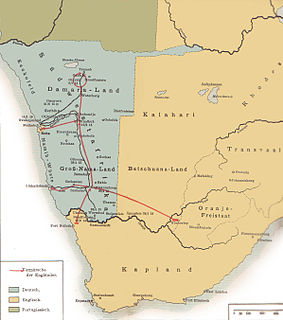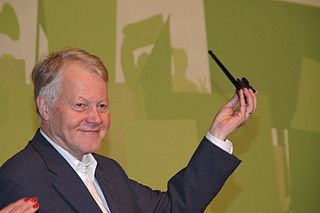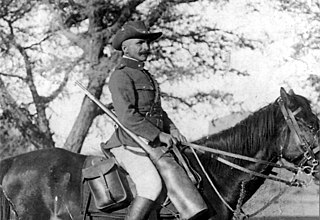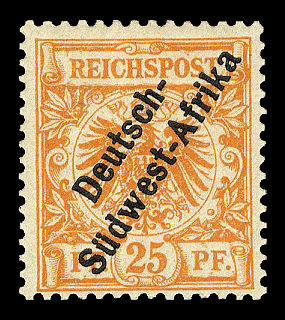
The South West Africa campaign was the conquest and occupation of German South West Africa by forces from the Union of South Africa acting on behalf of the British imperial government at the beginning of the First World War.

Winfried Nachtwei is a German politician and former member of Alliance '90/The Greens in the Bundestag. He is an expert on the Afghanistan conflict and works as a peace and conflict consultant since leaving the Bundestag. His nickname is "Winni".

The Battle of Sandfontein was fought between the Union of South Africa on behalf of the British Imperial Government and the German Empire on 26 September 1914 at Sandfontein, during the first stage of the South West Africa Campaign of World War I, and ended in a German victory.

Ludwig Gustav Adolf von Estorff was a German military officer who notably served as a Schutztruppe commander in Africa; and later as an Imperial German Army general in World War I. He also was a recipient of the Pour le Merite, Germany's highest military award.
Arbeiterverband für Südwestafrika was a trade union centre in South West Africa. It was an affiliate of the International Federation of Trade Unions 1929–1939. The affiliation to IFTU had been approved in principle, on the condition that Arbeiterverband remove its policy of blocking Africans from becoming members. The Arbeiterverband did however retain its policy of not allowing Africans to become members, arguing that the native workforce was not unionized at all. The IFTU then ignored its conditions of Arbeiterverband and the organization was recognized as an IFTU affiliate.

This is a survey of postage stamps and postal history of the German colonies and part of the postage stamps and postal history of Germany, as well as those of the individual countries and territories concerned.

Jonker Afrikaner was the fourth Captain of the Orlam in South West Africa, succeeding his father, Jager Afrikaner, in 1823. Soon after becoming Kaptein, he left his father's settlement at Blydeverwacht with three brothers and some 300 followers and relocated to the area that is today central Namibia. From 1825 onwards he and his council played a dominant political role in Damaraland and Namaland, creating a de facto state.

German South West Africa was a colony of the German Empire from 1884 until 1915, though Germany did not officially recognise its loss of this territory until the 1919 Treaty of Versailles. With a total area of 835,100 km², it was one and a half times the size of the mainland German Empire in Europe at the time. The colony had a population of around 2,600 Germans.

The Deutscher Pfadfinderbund in Namibia is a small Scouting association open mainly to boys and girls of German descent in Namibia.

German South West Africa was a German colony in Africa, established in 1884 with the protection of the area around Lüderitz and abandoned during World War I, when the area was taken over by the British.

Franz Heinrich Kleinschmidt (1812–1864) was a German missionary and linguist who worked in southern Africa, now in the region of Namibia. He founded the missionary station and town of Rehoboth and together with Carl Hugo Hahn set up the first Rhenish mission station to the Herero people in Gross Barmen. Kleinschmidt is known for his scientific work on the Nama language.

Tjamuaha was a chief of the Herero people in South-West Africa, today's Namibia, and the father of Maharero. He was a close ally and subordinate of Jonker Afrikaner, Captain of the Oorlam Afrikaners, and stayed with him in Windhoek for most of his chieftaincy. With Tjamuaha's death, hostilities started between the Nama people and the Herero.
Events in the year 1898 in Germany.
Events in the year 1915 in Germany.

Hermann Merxmüller was a German botanist and taxonomist.

Jackie Sibblies Drury is an American playwright. The New York Times called Drury's 2012 play We Are Proud to Present a Presentation About the Herero of Namibia, Formerly Known as Southwest Africa, From the German Sudwestafrika, Between the Years 1884-1915 "her breakout work". Her subsequent works include Social Creatures (2013) and Fairview (2018); for the latter, Drury received the 2019 Pulitzer Prize for Drama.
Conception Bay is a bay on the coast of Namibia, Africa. The bay is exposed, not providing a useful anchorage.

Metapterodon is an extinct genus of hyainailourid hyaenodonts of the tribe Metapterodontini withnin paraphyletic subfamily Hyainailourinae, that lived in Africa during the early Oligocene to early Miocene. Fossils of Metapterodon were recovered from the Egypt, Uganda, Elisabeth Bay Formation in Namibia, and Rusinga Island and Karungu in Kenya.

The Imperial Schutztruppe for German South west Africa was the official name of the military formation that maintained the German Empire in its colony of German South West Africa. The Schutztruppe are held responsible for numerous atrocities in the Herero and Nama uprising in 1904. During the First World War, the Schutztruppe was defeated by the troops of the Union of South Africa.

Squatting in Namibia is the occupation of unused land or derelict buildings without the permission of the owner. After Namibian independence in 1990, squatting increased as people migrated to the cities. By 2020, 401,748 people were living in 113 informal settlements across the country.















